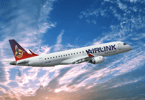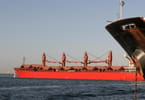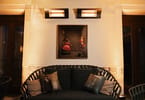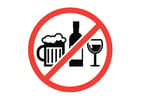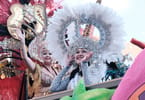The waiter carries a silver tray with Champagne sparkling in crystal flutes. He wears a black tailcoat of fine worsted wool as he serves an elegant lady resplendent in a red satin ball gown.
Formal night on the Europa, the most highly rated cruise ship in the world, begins with cocktails in a two-story atrium where a classical pianist performs on a Steinway. Afterward, passengers sit down to a five-course gourmet dinner. My menu is printed in English, but nearly all the passengers around me read their selections in the official language on board the ship: German.
Hapag-Lloyd, the German shipping giant, operates four ships in its leisure cruise division and the Europa is the star in its crown. The only cruise ship in the world rated five star-plus by the bible of the cruise industry, the “Berlitz Guide to Cruising and Cruise Ships,” it occupies a class by itself. It has held that position for the past eight years.
Most Americans, even veteran cruisers, do not know the Europa because Hapag-Lloyd has not marketed its ships on this side of the Atlantic. That is gradually changing as the cruise line engages in bilingual cruises. On these cruises, English-speaking passengers, whether they be American, British or Australian, receive menus, daily programs, travel documents, video presentations and a limited number of shore excursions in English. The entire crew speaks English, including a maintenance man who asked my husband if he was voting for Obama or McCain.
Nine cruises have been designated bilingual in 2009. In addition, if 15 or more English-speaking passengers reserve a cruise, it automatically becomes bilingual with announcements and shore excursions in English. On other cruises, passengers can make a request in advance for English menus and other printed information, and the concierge on board will arrange individual shore excursions in English.
The Europa draws seasoned, sophisticated travelers wealthy enough to afford this level of service. The average age of passengers is around 65, guesses Hapag-Lloyd Cruises managing director, Sebastian Ahrens, though it drops during school holidays when up to 42 children can be accommodated on board.
Despite the cost, the Europa almost always sets out fully booked. The luxury cruise market does not suffer the effects of a downturn in the economy unlike other segments of the travel industry, says Ahrens. Those with money continue to spend it.
What makes the Europa worth the cost, and worthy of five star-plus status? In a nutshell: space and service.
The Europa has the highest passenger space ratio in the cruise industry, with large public areas that never feel crowded. Private spaces also are roomy. Each guest room is a suite, the smallest measuring 290 square feet, and 80 percent have balconies. My jaw dropped when I laid eyes on the walk-in closet, something I have not seen even on other luxury ships. Storage space is typically tight, but in this suite I had drawers and hangers to spare. Bathrooms on most ships also are tiny, but those on the Europa have a bathtub and separated glassed-in shower roomy enough for an NFL lineman. The suite’s sitting area contains a chair, sofa bed, mini-bar with free beer, juice and soft drinks. A desk houses a keyboard for accessing a free e-mail account using the TV screen, where passengers also can view on-demand movies, shipboard programs and television channels in both German and English.
The ship, launched in 1999, is small in comparison to the 6,000-passenger mega-ships being built today. A crew of 280 caters to just 400 passengers, the highest staff/passenger ratio of any cruise ship. This makes top-notch service possible.
“Smaller ships are especially good for seasoned travelers,” says cruise expert Douglas Ward, author of the Berlitz guide. “Big cruise ships don’t have the finesse of the smaller ships.”
Crew members have years of training in the hotel business in Europe and consider a position on the Europa a career-building move. “It is the crew that is the most important part of the cruise,” says Ward. Europa crew members “have very good passenger recognition.” On a two-week voyage, they often recall names, faces and passengers’ special needs and requests.
On top of great service, Ward says the Europa earns its stars in its attention to detail. Fish courses are served with a fish knife. Coffee comes with three kinds of sugar, in addition to sugar substitute. A doily on a stemmed beer glass catches condensation. China and cutlery are top of the line. In the Oriental restaurant, one of four restaurants on board, the china plates have a rare flying fish pattern replicated from a 1920s design. Each plate, if you could buy it retail, would cost 350 to 400 euros.
Menu items cover a wide range of cuisines. The ship offers 8,000 food items, compared to around 3,000 on most cruises, and carries 17,000 bottles of wine covering vintages from all the world’s top wine-producing areas.
Still, the Europa is not perfect. More than once on our cruise, mistakes in the time of activities listed on the daily printed program confused and frustrated passengers. All the fish knives in the world can’t make up for missing an excursion due to a miscommunication.
And while ours was one of the designated bilingual cruises scheduled in 2008, not all of the announcements on board were repeated in English. This was especially disappointing because the theme of our cruise was the ship’s annual Ocean Sun Festival, with performances by classical music artists. Since music is a universal language, it made no difference that the featured soprano and tenor sang arias in Italian or German, but we were disheartened when introductions to each piece were given in German only. Still, since we were the only Americans among just a handful of non-German speakers on board, we could understand the reluctance to inconvenience so many for so few.
On most voyages, the Europa showcases at least half a dozen musicians and vocalists in programs that include about 60 percent classical music. During the Ocean Sun Festival, which will be offered again in 2009 on the Aug. 12-22 sailing, eight internationally acclaimed artists perform in an entertainment program that is 80 percent to 90 percent classical music. The festival is gaining a reputation among classical music fans similar to that of Napa’s prestigious Festival del Sole and Italy’s Tuscan Sun Festival.
In addition to afternoon and evening performances on board during the festival, free private concerts are held in port. While in Cadiz, Spain, we traveled to the 13th-century Castillo San Marcos, where Christopher Columbus lived while planning his voyage to America. After cocktails and canapés in the courtyard, renowned German-Canadian Mozart tenor Michael Schade sang for us in the cloisters. In Majorca, Schade joined soprano Andrea Rost in a concert with the Orquestra Clasica de Balears at the Teatro Principal. On board after dinner, lighter musical fare in the Clipper Bar featured a chanteuse singing in the style of Edith Piaf.
The Europa doesn’t confine itself to voyages in Europe. Next year’s bilingual cruises will call in the South Pacific, Australia, China, Japan, Thailand, Vietnam, India, Libya and the Arab Emirates, in addition to the Baltics, Italy and Greece.
When not exploring ports, passengers enjoy the ship’s many amenities, including a spa, saltwater pool with retractable roof, 21-course golf simulator with PGA pro on hand for lessons, and a fitness loft with ocean view. Above the loft, at the top of the ship, is an area not found on American vessels: A deck for those who choose to sunbathe in the nude – European style.
• Information for this article was gathered on a research trip sponsored by Hapag-Lloyd Cruises.
If you go
Information: Hapag-Lloyd Cruises, (877) 445-7447, www.hl-cruises.com
Itineraries and cost: Bilingual cruises in 2009 range in price and duration from a 10-day voyage from Barcelona to the Canary Islands starting at about $6,000 per person to an 18-day voyage from Tahiti to Australia starting at about $9,900 per person. Gratuities not expected. A 5 percent discount is offered for early booking.
Dress code: More formal than on most American ships, with men wearing a suit or sport coat most evenings and a tuxedo or dinner jacket on formal nights.
Dining: Open seating in one sitting at dinner. Reservations taken in the formal dining room, and necessary (and much sought after) in two specialty restaurants. Though a German ship, cuisine includes dishes from around the world.
WHAT TO TAKE AWAY FROM THIS ARTICLE:
- Formal night on the Europa, the most highly rated cruise ship in the world, begins with cocktails in a two-story atrium where a classical pianist performs on a Steinway.
- The only cruise ship in the world rated five star-plus by the bible of the cruise industry, the “Berlitz Guide to Cruising and Cruise Ships,”.
- Crew members have years of training in the hotel business in Europe and consider a position on the Europa a career-building move.









